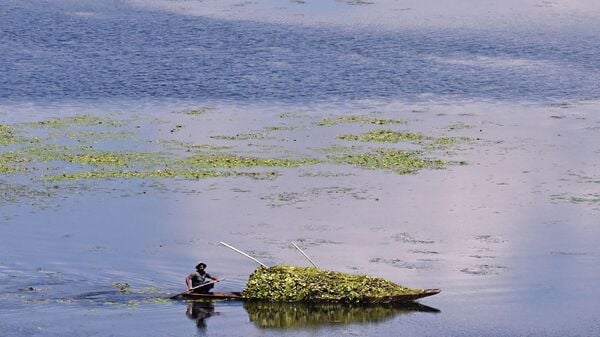Lotus blooms in Kashmir’s Wular Lake after 3 decades, locals hope for livelihood revival

After three decades, lotus flowers have returned to Kashmir’s Wular Lake, igniting hope among local communities that once thrived on this vital resource. Efforts to restore the lake’s ecology through desilting are paving the way for economic revival linked to the prized lotus stem.
Lotus flowers have started blooming in Kashmir’s Wular Lake after three decades. The reappearance of the flower crop in north Kashmir’s river has renewed hope for communities that once depended on the lake for their livelihood.
The flowers—known for their stems, nadru, a prized vegetable in the Valley’s largely non-vegetarian cuisine—disappeared after the devastating 1992 floods deposited thick layers of silt across the lakebed.
The revival of the lotus is being attributed to an ongoing desilting and restoration project by the Wular Lake Management Authority.
The efforts, which started in 2020, aim to restore the lake’s original depth and improve water flow by removing silt and waste carried by the Jhelum River and its tributaries.“We thought this would never return,” Mohammad Yaqoob, a local farmer from Watlab village in the neighbourhood, told a local news agency in Kashmir.
“My father used to harvest lotus stems here. I used to help him when I was young. Then the flood came and everything changed,” he said.
Spread over nearly 200 square kilometres and located between the towns of Bandipora and Sopore, Wular Lake was once a major source of income for hundreds of families in the region from Asia’s largest freshwater lake.
The lotus stem, a staple in traditional Kashmiri cuisine, also provided seasonal employment,especially during the harsh winters when other livelihood options were scarce.
Lotus also grows in Dal Lake and Manasbal Lake in the Valley.
Officials said that while lotus stems hadn’t been seen for decades, the plant’s root structures remained buried beneath the silt.
“The lotus has seen a revival in areas where we have removed silt over the last few years. Since lotus seeds were buried deep inside the silt and soil, they couldn’t grow. Now that the silt has been removed, lotus has again grown,” says Mudasir Ahmad, a zonal officer of the Wular Conservation and Management Authority, told the Indian Express.
The desilting work has removed over 7.9 million cubic meters of silt from the lake so far, the officials said. This year, the authorities introduced lotus seeds in areas where dredging had been completed.
The authorities involved in the conservation plan said the larger goal is to install retention basins along major streams to stop future silt and waste from entering the lake.
Zahoor Ahmad, a resident of Laharwalpora, said local families had tried to reintroduce the lotus on their own. “We threw seeds into the lake many times, but nothing grew,” he said.
“It’s only now, after the silt was cleared, that we see the flowers again.”
Ahmad told the news agency that the return of the lotus is not only a sign of ecological improvement but also a source of renewed economic activity for many households around the lake
Kashmir saw devastating floods in September 1992, which caused considerable damage to the rich ecosystem of Wular Lake by depositing a large quantity of silt that buried the lotus vegetation.
(With agency inputs)






